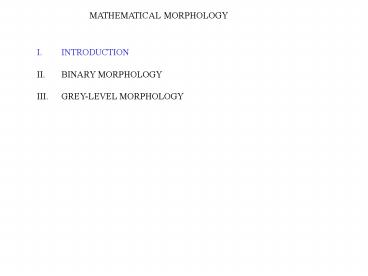Presentacin de PowerPoint - PowerPoint PPT Presentation
1 / 63
Title:
Presentacin de PowerPoint
Description:
Self-sufficient framework for image processing and analysis, created at the ... duality of erosion-dilation, opening-closing,... structuring elements decomposition ... – PowerPoint PPT presentation
Number of Views:84
Avg rating:3.0/5.0
Title: Presentacin de PowerPoint
1
MATHEMATICAL MORPHOLOGY
- INTRODUCTION
- BINARY MORPHOLOGY
- GREY-LEVEL MORPHOLOGY
2
INTRODUCTION
- Mathematical morphology
- Self-sufficient framework for image processing
and analysis, created at the École des Mines
(Fontainebleau) in 70s by Jean Serra, Georges
Mathéron, from studies in science materials - Conceptually simple operations combined to define
others more and more complex and powerful - Simple because operations often have geometrical
meaning - Powerful for image analysis
3
INTRODUCTION
- Binary and grey-level images seen as sets
X
Xc
X (x, y, z) , z ? f (x,y)
f (x,y)
4
INTRODUCTION
- Operations defined as interaction of images with
a special set, the structuring element
5
MATHEMATICAL MORPHOLOGY
- INTRODUCTION
- BINARY MORPHOLOGY
- GREY-LEVEL MORPHOLOGY
6
BINARY MORPHOLOGY
- Erosion and dilation
- Common structuring elements
- Opening, closing
- Properties
- Hit-or-miss
- Thinning, thickenning
- Other useful transforms
- Contour
- Convex-hull
- Skeleton
- Geodesic influence zones
7
BINARY MORPHOLOGY
Notation
x
-2 -1 0 1 2
-2 -1 0 1 2
B
y
A special set the structuring element
Origin at center in this case, but not
necessarily centered nor symmetric
X
No necessarily compact nor filled
8
BINARY MORPHOLOGY
Dilation x (x1,x2) such that if we center B
on them, then the so translated B
intersects X.
X
difference
B
9
BINARY MORPHOLOGY
Dilation x (x1,x2) such that if we center B
on them, then the so translated B
intersects X. How to formulate this definition ?
1) Literal translation
2) Better from Minkowskis sum of sets
10
BINARY MORPHOLOGY
Minkowskis sum of sets
l
l
11
BINARY MORPHOLOGY
Dilation
l
Dilation
12
BINARY MORPHOLOGY
Dilation is not the Minkowskis sum
l
13
BINARY MORPHOLOGY
l
l
14
BINARY MORPHOLOGY
Dilation with other structuring elements
15
BINARY MORPHOLOGY
Dilation with other structuring elements
16
BINARY MORPHOLOGY
Erosion x (x1,x2) such that if we center B on
them, then the so translated B is
contained in X.
difference
17
BINARY MORPHOLOGY
Erosion x (x1,x2) such that if we center B on
them, then the so translated B is
contained in X. How to formulate this definition
? 1) Literal translation
2) Better from Minkowskis substraction of sets
18
BINARY MORPHOLOGY
19
BINARY MORPHOLOGY
Erosion with other structuring elements
20
BINARY MORPHOLOGY
Erosion with other structuring elements
Did not belong to X
21
BINARY MORPHOLOGY
Common structuring elements shapes
origin
x
y
circle
disk
segments 1 pixel wide
Note
points
22
BINARY MORPHOLOGY
Problem
23
BINARY MORPHOLOGY
24
BINARY MORPHOLOGY
Problem
ltd/2
d/2
d
25
BINARY MORPHOLOGY
Implementation very low computational cost
0
1 (or gt0)
Logical or
26
BINARY MORPHOLOGY
Implementation very low computational cost
0
1
Logical and
27
BINARY MORPHOLOGY
Opening
also
difference
- Supresses
- small islands
- ithsmus (narrow unions)
- narrow caps
28
BINARY MORPHOLOGY
Opening with other structuring elements
29
BINARY MORPHOLOGY
Closing
also
- Supresses
- small lakes (holes)
- channels (narrow separations)
- narrow bays
30
BINARY MORPHOLOGY
Closing with other structuring elements
31
BINARY MORPHOLOGY
Application shape smoothing and noise filtering
32
BINARY MORPHOLOGY
Application segmentation of microstructures
(Matlab Help)
33
BINARY MORPHOLOGY
- Properties
- all of them are increasing
- opening and closing are idempotent
34
BINARY MORPHOLOGY
- dilation and closing are extensive erosion and
opening are anti-extensive
35
BINARY MORPHOLOGY
- duality of erosion-dilation, opening-closing,...
36
BINARY MORPHOLOGY
- structuring elements decomposition
operations with big structuring elements can be
done by a succession of operations with small
s.es
37
BINARY MORPHOLOGY
Hit-or-miss
Bi-phase structuring element
Hit part (white)
Miss part (black)
38
BINARY MORPHOLOGY
Looks for pixel configurations
background
foreground
doesnt matter
39
BINARY MORPHOLOGY
isolated points at4 connectivity
40
BINARY MORPHOLOGY
Thinning
Thickenning
- Depending on the structuring elements (actually,
series - of them), very different results can be achieved
- Prunning
- Skeletons
- Zone of influence
- Convex hull
- ...
41
BINARY MORPHOLOGY
Prunning at 4 connectivity remove end points by
a sequence of thinnings
1 iteration
42
BINARY MORPHOLOGY
1st iteration
2nd iteration
3rd iteration idempotence
43
BINARY MORPHOLOGY
What does the following sequence ?
doesnt matter
background
foreground
44
BINARY MORPHOLOGY
- Erosion and dilation
- Common structuring elements
- Opening, closing
- Properties
- Hit-or-miss
- Thinning, thickenning
- Other useful transforms
- Contour
- Convex-hull
- Skeleton
- Geodesic influence zones
45
BINARY MORPHOLOGY
i. Contours of binary regions
46
BINARY MORPHOLOGY
Important for perimeter computation.
47
BINARY MORPHOLOGY
ii. Convex hull union of thickenings, each up
to idempotence
48
BINARY MORPHOLOGY
49
BINARY MORPHOLOGY
iii. Skeleton
Maximal disk disk centered at x, Dx, such that
Dx ? X and no other Dy contains it . Skeleton
union of centers of maximal disks.
50
BINARY MORPHOLOGY
- Problems
- Instability infinitessimal variations in the
border of X - cause large deviations of the skeleton
- not necessarily connex even though X connex
- good approximations provided by thinning with
- special series of structuring elements
51
BINARY MORPHOLOGY
1st iteration
52
BINARY MORPHOLOGY
result of 1st iteration
2nd iteration reaches idempotence
53
BINARY MORPHOLOGY
20 iterations thinning
40 iterations thickening
54
BINARY MORPHOLOGY
Application skeletonization for OCR by graph
matching
55
BINARY MORPHOLOGY
Application skeletonization for OCR by graph
matching
56
BINARY MORPHOLOGY
iv. Geodesic zones of influence
X set of n connex components Xi, i1..n . The
zone of influence of Xi , Z(Xi) , is the set
of points closer to some point of Xi than to a
point of any other component. Also, Voronoi
partition. Dual to skeleton.
57
BINARY MORPHOLOGY
58
BINARY MORPHOLOGY
59
BINARY MORPHOLOGY
60
BINARY MORPHOLOGY
61
BINARY MORPHOLOGY
62
BINARY MORPHOLOGY
63
BINARY MORPHOLOGY
dist































